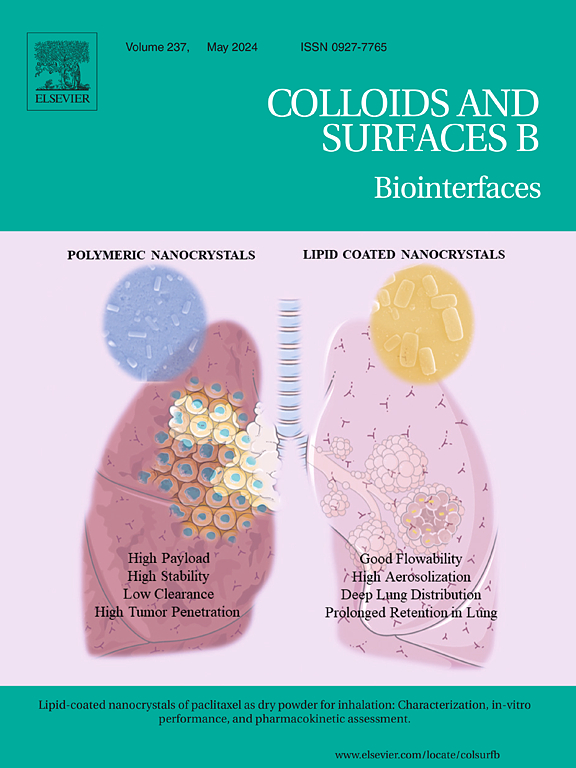A dual-functional mitochondrial probe for melanoma visualization and PI3K/AKT/mTOR-EMT signaling axis-mediated antitumor therapy
IF 5.6
2区 医学
Q1 BIOPHYSICS
引用次数: 0
Abstract
Melanoma is a highly metastatic cancer with poor treatment outcomes. Mitochondria, regulated by various signaling pathways, are an important target in cancer therapy. Near-infrared (NIR) fluorescence probes have gained interest due to their properties such as deep tissue penetration, high image sensitivity, and precision targeting. In this study, we developed a novel NIR fluorescent probe IR-545 for melanoma imaging, which demonstrated mitochondrial targeting and antitumor activity in melanoma cells. In vitro experiments showed that IR-545 was taken up by melanoma cells through organic anion-transport polypeptides and targeted tumor cell mitochondria. IR-545 induced apoptosis by inhibiting the PI3K/AKT/mTOR pathway and epithelial–mesenchymal transition (EMT) and suppressed the proliferation and metastasis of melanoma cells. In vivo, IR-545 significantly inhibited tumor growth in BALB/c nude mice. Immunofluorescence, immunohistochemistry, and H&E staining confirmed that IR-545 induced tumor cell apoptosis and inhibited proliferation without notable side effects. In conclusion, IR-545 shows significant potential in imaging and treating melanoma, offering a promising new therapeutic approach.
双功能线粒体探针用于黑色素瘤可视化和PI3K/AKT/mTOR-EMT信号轴介导的抗肿瘤治疗
黑色素瘤是一种高度转移的癌症,治疗效果很差。线粒体受多种信号通路的调控,是肿瘤治疗的重要靶点。近红外(NIR)荧光探针由于其深层组织穿透、高图像灵敏度和精确靶向等特性而引起了人们的兴趣。在这项研究中,我们开发了一种新的近红外荧光探针IR-545用于黑色素瘤成像,它证明了黑色素瘤细胞的线粒体靶向和抗肿瘤活性。体外实验表明,IR-545通过有机阴离子转运多肽和靶向肿瘤细胞线粒体被黑色素瘤细胞摄取。IR-545通过抑制PI3K/AKT/mTOR通路和上皮-间质转化(epithelial-mesenchymal transition, EMT)诱导细胞凋亡,抑制黑色素瘤细胞的增殖和转移。在体内,IR-545显著抑制BALB/c裸鼠的肿瘤生长。免疫荧光、免疫组织化学和H&;E染色证实IR-545诱导肿瘤细胞凋亡,抑制肿瘤细胞增殖,无明显副作用。总之,IR-545在黑色素瘤成像和治疗方面显示出巨大的潜力,提供了一种有前景的新治疗方法。
本文章由计算机程序翻译,如有差异,请以英文原文为准。
求助全文
约1分钟内获得全文
求助全文
来源期刊

Colloids and Surfaces B: Biointerfaces
生物-材料科学:生物材料
CiteScore
11.10
自引率
3.40%
发文量
730
审稿时长
42 days
期刊介绍:
Colloids and Surfaces B: Biointerfaces is an international journal devoted to fundamental and applied research on colloid and interfacial phenomena in relation to systems of biological origin, having particular relevance to the medical, pharmaceutical, biotechnological, food and cosmetic fields.
Submissions that: (1) deal solely with biological phenomena and do not describe the physico-chemical or colloid-chemical background and/or mechanism of the phenomena, and (2) deal solely with colloid/interfacial phenomena and do not have appropriate biological content or relevance, are outside the scope of the journal and will not be considered for publication.
The journal publishes regular research papers, reviews, short communications and invited perspective articles, called BioInterface Perspectives. The BioInterface Perspective provide researchers the opportunity to review their own work, as well as provide insight into the work of others that inspired and influenced the author. Regular articles should have a maximum total length of 6,000 words. In addition, a (combined) maximum of 8 normal-sized figures and/or tables is allowed (so for instance 3 tables and 5 figures). For multiple-panel figures each set of two panels equates to one figure. Short communications should not exceed half of the above. It is required to give on the article cover page a short statistical summary of the article listing the total number of words and tables/figures.
 求助内容:
求助内容: 应助结果提醒方式:
应助结果提醒方式:


